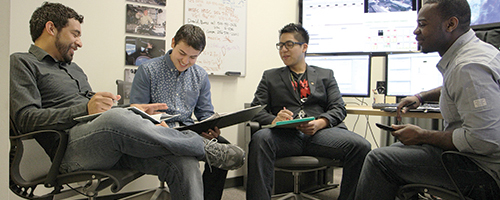A group of six Master of Urban and Regional Planning students led a workshop in the Cully neighborhood of Portland Thursday evening to address and prioritize community concerns about development and displacement in the area.
PSU students address gentrification in Cully
[portfolio_slideshow id=49970]
A group of six Master of Urban and Regional Planning students led a workshop in the Cully neighborhood of Portland Thursday evening to address and prioritize community concerns about development and displacement in the area.
Held at Rigler School, the workshop saw around 25 attendees and served as a follow-up to a similar community meeting held in early April. The workshops are just one component of a larger effort between the students and local organizations to identify and address the neighborhood’s needs through smaller gatherings, interviews and research.
“It can be really effective when community organizations come together with a strategy that’s based on community needs,” said Cary Watters, a MURP student working on the project, as she addressed the group at the beginning of the workshop.
At the workshop, which was designed as a presentation and feedback session, the students presented a package of 16 different draft strategies formed along five themed workstations: housing, jobs, families, community and neighborhood businesses.
Attendees split up into groups and rotated through the workstations, discussing the strategies with the students while offering their own insights and concerns. By the end of the meeting, attendees had emphasized affordable child care and the establishment of a community center as the neighborhood’s priorities.
According to Rebecca Kennedy, another student working on the project, the group supplements the workshops with outreach efforts aimed at community residents who, for various reasons, are unable to attend the larger meetings. This broadens the scope of the input they receive from the community as a whole, she said.
The students, who began the project in January, are working alongside three nonprofit organizations that operate in the neighborhood: Verde, Hacienda Community Development Corporation and the Native American Youth and Family Center. These organizations established the “Living Cully: A Cully Ecodistrict” anti-poverty strategy in 2010 “to drive environmental investments into the Cully [n]eighborhood in response to existing community needs,” according to a press release.
The Cully neighborhood is Portland’s most ethnically diverse, but suffers from “poor street connectivity and a lack of basic infrastructure,” according to the City of Portland’s “Cully Commercial Corridor and Local Street Plan” dated September 2012. “Of all Portland neighborhoods,” it continues, “Cully ranks second in the most number of miles of unpaved streets.” Just under two-thirds of the neighborhood’s streets lack sidewalks, which “makes walking and cycling more difficult and fosters dependency on the automobile.”
A lack of commercial zoning means that the neighborhood lacks a strong core of businesses serving the neighborhood. Two percent of Cully is zoned for commercial use, while in the rest of Portland 10 percent is more common. According to the “Portland Plan,” a 2035-oriented action plan for the city that addresses things like public health, education and social equity, only 17 percent of residents in Cully (and its adjacent neighborhood, Roseway) live within half a mile of a grocery store.
So how did Cully end up this way? According to the Cully street plan, the neighborhood “developed as an unincorporated neighborhood in Multnomah County, and, as such, did not receive urban-level investments in street system infrastructure, parks and recreation facilities and services.” The report adds that many Cully residents may not have the means to remain in the area if development drove up the cost of living in the neighborhood and “gentrification were to occur.”
It’s this sort of displacement that the MURP students and Living Cully are working to prevent.
Tony DeFalco, a staff member at Verde and the coordinator of Living Cully, said the neighborhood was selected for this work due to its being identified as vulnerable to involuntary displacement in a report currently being drafted by the City of Portland’s Bureau of Planning and Sustainability.
DeFalco is optimistic that current efforts can help to maintain community stability while improving residents’ well-being, including their access to “environmental wealth” like parks and open space.
“We feel like we have a chance here,” to bring effective strategies to bear, DeFalco said. “I think this community has shown a lot of support,” for this kind of effort, he added. The goal, he said at the workshop, is to guide investment in a way that doesn’t displace people from the neighborhood.
The information gleaned from the MURP students’ work will culminate in a report that will be distributed in June to Living Cully’s member organizations, who from that point will follow up on the report’s findings and suggestions as they see fit.
“This is really the beginning,” DeFalco said as he addressed the group at the end of the workshop. “We have a responsibility to help guide investment in a way that doesn’t displace people from the neighborhood.”





